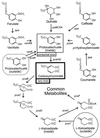Bacteria are not what they eat: that is why they are so diverse
- PMID: 10629168
- PMCID: PMC94271
- DOI: 10.1128/JB.182.2.257-263.2000
Bacteria are not what they eat: that is why they are so diverse
Figures




Similar articles
-
Isolation of acidophilic methane-oxidizing bacteria from northern peat wetlands.Science. 1998 Oct 9;282(5387):281-4. doi: 10.1126/science.282.5387.281. Science. 1998. PMID: 9765151
-
Gemmatimonas aurantiaca gen. nov., sp. nov., a gram-negative, aerobic, polyphosphate-accumulating micro-organism, the first cultured representative of the new bacterial phylum Gemmatimonadetes phyl. nov.Int J Syst Evol Microbiol. 2003 Jul;53(Pt 4):1155-1163. doi: 10.1099/ijs.0.02520-0. Int J Syst Evol Microbiol. 2003. PMID: 12892144
-
Conditions for natural transformation of Ralstonia solanacearum.Appl Environ Microbiol. 1997 Dec;63(12):4965-8. doi: 10.1128/aem.63.12.4965-4968.1997. Appl Environ Microbiol. 1997. PMID: 9406418 Free PMC article.
-
Pink-pigmented non-fermentative gram-negative rods associated with human infections: a clinical and diagnostic challenge.Infection. 2007 Jun;35(3):126-33. doi: 10.1007/s15010-007-6282-x. Infection. 2007. PMID: 17565452 Review.
-
[Evolution and phylogeny of rhizobia].Rev Latinoam Microbiol. 2005 Jan-Jun;47(1-2):43-60. Rev Latinoam Microbiol. 2005. PMID: 17061545 Review. Spanish.
Cited by
-
Diverse organization of genes of the beta-ketoadipate pathway in members of the marine Roseobacter lineage.Appl Environ Microbiol. 2004 Mar;70(3):1658-68. doi: 10.1128/AEM.70.3.1658-1668.2004. Appl Environ Microbiol. 2004. PMID: 15006791 Free PMC article.
-
Origins of the 2,4-dinitrotoluene pathway.J Bacteriol. 2002 Aug;184(15):4219-32. doi: 10.1128/JB.184.15.4219-4232.2002. J Bacteriol. 2002. PMID: 12107140 Free PMC article.
-
Mutational analysis of the critical bases involved in activation of the AreR-regulated sigma54-dependent promoter in Acinetobacter sp. strain ADP1.Appl Environ Microbiol. 2003 Sep;69(9):5627-35. doi: 10.1128/AEM.69.9.5627-5635.2003. Appl Environ Microbiol. 2003. PMID: 12957953 Free PMC article.
-
Dynamics of benzoate metabolism in Pseudomonas putida KT2440.Metab Eng Commun. 2016 Mar 15;3:97-110. doi: 10.1016/j.meteno.2016.03.005. eCollection 2016 Dec. Metab Eng Commun. 2016. PMID: 29468117 Free PMC article.
-
Characterization of the protocatechuic acid catabolic gene cluster from Streptomyces sp. strain 2065.Appl Environ Microbiol. 2000 Apr;66(4):1499-508. doi: 10.1128/AEM.66.4.1499-1508.2000. Appl Environ Microbiol. 2000. PMID: 10742233 Free PMC article.
References
-
- Andersson D I, Slechta E S, Roth J R. Evidence that gene amplification underlies adaptive mutability of the bacterial lac operon. Science. 1998;282:1133–1135. - PubMed
-
- Bernards M A, Lewis N G. The macromolecular aromatic domain in suberized tissue: a changing paradigm. Phytochemistry. 1998;47:915–933. - PubMed
-
- Canovas J L, Ornston L N, Stanier R Y. Evolutionary significance of metabolic control systems. The β-ketoadipate pathway provides a case history in bacteria. Science. 1967;156:1695–1699. - PubMed
Publication types
MeSH terms
Substances
LinkOut - more resources
Full Text Sources

